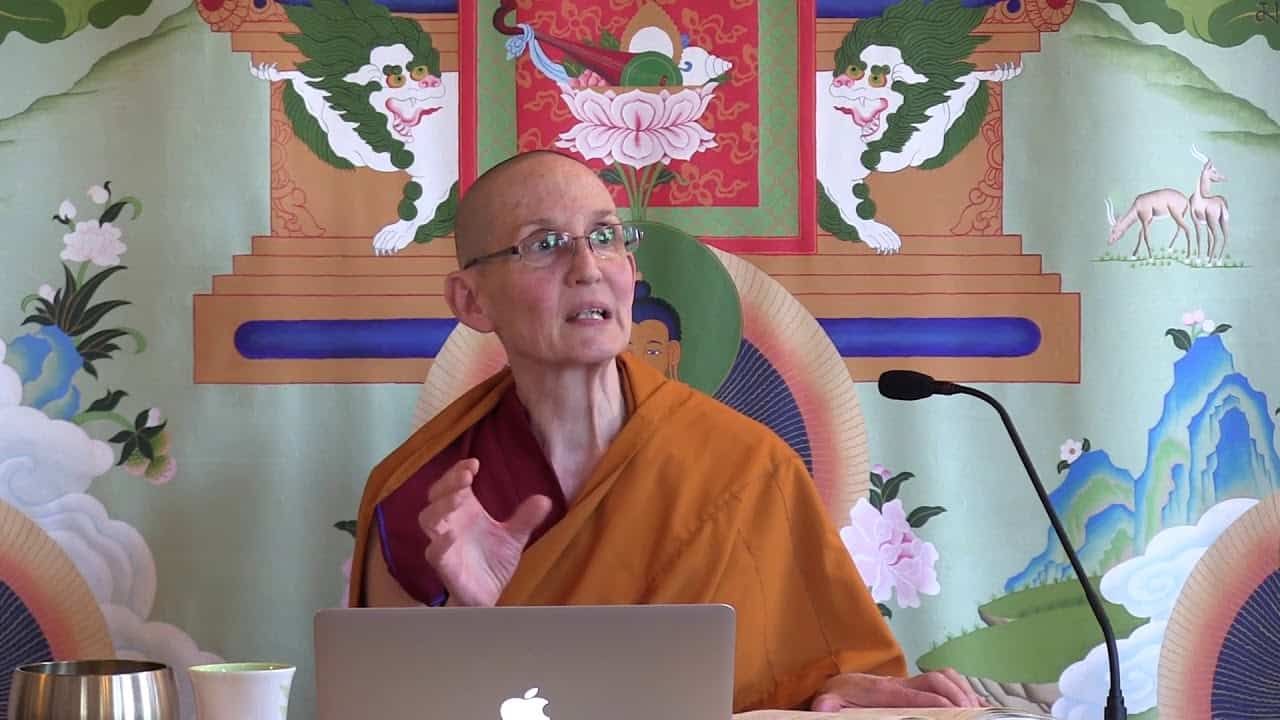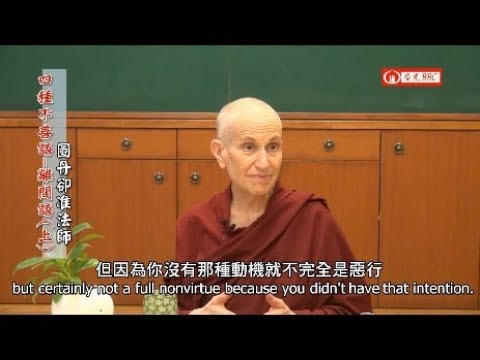Review: Nine stages of sustained attention
The text turns to training the mind on the stages of the path of advanced level practitioners. Part of a series of teachings on the Gomchen Lamrim by Gomchen Ngawang Drakpa. Visit Gomchen Lamrim Study Guide for a full list of contemplation points for the series.
- History and source of the teachings on concentration
- The characteristics of each stage
- Faults and their antidotes according to your level
- Explanation of the Tibetan thangkha that depicts these stages
- Signs of the attainment of serenity
Download the test here and the answer key here (image by Buddha in the Mud).
133 Gomchen Lamrim: Review 9 Stages of Sustained Attention (download)
Contemplation points
- The first stage of sustained attention (placing the mind) is about identifying the object of meditation and keeping the mind there. With that in mind, spend some time considering the imagery used to represent this first stage: the monk represents the meditator, the rope represents mindfulness, the hook represents introspective awareness, the elephant represents the mind itself, the monkey represents scattering, the flame (seen throughout the graphic) represents energy, the dark color of the elephant represents laxity, and the dark color of the monkey represents agitation. What does this imagery say about the state of our mind and the antidotes we need to employ to cultivate this level of concentration?
- In the second stage of sustained attention (continual placement) we’re able to keep the mind on the object a little longer, and begin to notice when we’re on the object and when we’re distracted. With that in mind, spend some time considering the imagery used to represent this second stage: the white spots on the heads of the monkey and elephant, the fruit represents objects of taste, the cloth represents object of tactile sensation, the fire (which is still quite big at this time) represents energy. What does this imagery say about the state of our mind at this stage, what we have attained, and the obstacles we are still working to overcome?
- In the third stage of sustained attention (repeated placement) we recognize distraction when it happens and can put the mind back on the object. With that in mind, spend some time considering the imagery used to represent this third stage: the meditator has the rope around the elephants neck, the cymbals represent attachment to objects of sound and yet the animals are looking away from them towards the meditator, the fire is smaller, the rabbit appears (representing subtle laxity). What does this imagery say about the state of our mind at this stage, what we have attained, and the obstacles we are still working to overcome?
- In the fourth stage of sustained attention (close placement), we are familiar with the object and can set our mind on it; the mind is very stable on the object and we no longer lose it. With that in mind, spend some time considering the imagery used to represent this stage: the monk is much closer to the elephant now, the animals are half light and half dark, there’s a perfume conch representing attachment to objects of smell. What does this imagery say about the state of our mind at this stage, what we have attained, and the obstacles we are still working to overcome?
- In the fifth stage of sustained attention (taming), the mind is tame and can stay on the object almost continuously. With that in mind, spend some time considering the imagery used to represent this stage: for the first time, the monk is in front of the elephant and the monkey is behind the elephant, the animals are all looking at the monk, the monk has a hook on the elephant’s head (representing that the meditator has generated introspective awareness). What does this imagery say about the state of our mind at this stage, what we have attained, and the obstacles we are still working to overcome?
- In the sixth stage of sustained attention (pacifying), all dislike for meditative stabilization is overcome and the meditator is completely certain that distractions should be eliminated. With that in mind, spend some time considering the imagery used to represent this stage: the monk no longer has to look at the animals to lead them, a mirror is above that represents attachment to objects of sight, the rabbit is gone, and the monk still has the hook but it is no longer on the elephant. What does this imagery say about the state of our mind at this stage, what we have attained, and the obstacles we are still working to overcome?
- In the seventh stage of sustained attention (thoroughly pacifying), the mind is completely pacified, no effort is needed to stay on the object, and its easy for the meditator to suppress any affliction that arises both on and off the cushion. With that in mind, spend some time considering the imagery used to represent this stage: the monk is empty handed (no longer has rope or hook in hand), the monk is once again behind the elephant, there is no fire, the monkey is still there, and the legs of the elephant are still dark. What does this imagery say about the state of our mind at this stage, what we have attained, and the obstacles we are still working to overcome?
- In the eighth stage of sustained attention (making single-pointed), the mind stays on the object without interruption with only a little effort at the beginning of the session. With that in mind, spend some time considering the imagery used to represent this stage: the monk is in front and pointing gently to the elephant, the elephant is completely white, and the monkey has disappeared. What does this imagery say about the state of our mind at this stage, what we have attained, and the obstacles we are still working to overcome?
- In the ninth stage of sustained attention (placement in equipoise), meditation flows quite naturally, just the wish to meditate is sufficient, and the senses no longer respond to stimuli. With that in mind, spend some time considering the imagery used to represent this stage: the monk meditates, the elephant is sleeping, and there is a line coming out of the monk’s chest leading to further attainments after stage 9. What does this imagery say about the state of our mind at this stage, what we have attained, and the obstacles we are still working to overcome?
- The final image represents what happens after we complete the ninth stage: special pliancy that comes with supreme joy and bliss, followed by the attainment of serenity. Spend some time considering the imagery here: the flying monk, the monk riding on the back of the elephant, the monk holding a sword (representing insight), reaching out to cut the two rainbows (representing afflictive obscurations and mental distortions), and the fire reappears. What does this say about the state of our mind at this stage and what we are trying to achieve?
- Venerable Damcho said that when we meditate repeatedly on the benefits of doing something, our mind naturally goes in that direction. Consider the benefits of concentration at each of these levels, how they would benefit you and others, and resolve to meditate on these benefits in order to guide your mind towards cultivating concentration in your own life.
Venerable Thubten Damcho
Ven. Damcho (Ruby Xuequn Pan) met the Dharma through the Buddhist Students’ Group at Princeton University. After graduating in 2006, she returned to Singapore and took refuge at Kong Meng San Phor Kark See (KMSPKS) Monastery in 2007, where she served as a Sunday School teacher. Struck by the aspiration to ordain, she attended a novitiate retreat in the Theravada tradition in 2007, and attended an 8-Precepts retreat in Bodhgaya and a Nyung Ne retreat in Kathmandu in 2008. Inspired after meeting Ven. Chodron in Singapore in 2008 and attending the one-month course at Kopan Monastery in 2009, Ven. Damcho visited Sravasti Abbey for 2 weeks in 2010. She was shocked to discover that monastics did not live in blissful retreat, but worked extremely hard! Confused about her aspirations, she took refuge in her job in the Singapore civil service, where she served as a high school English teacher and a public policy analyst. Offering service as Ven. Chodron’s attendant in Indonesia in 2012 was a wake-up call. After attending the Exploring Monastic Life Program, Ven. Damcho quickly moved to the Abbey to train as an Anagarika in December 2012. She ordained on October 2, 2013 and is the Abbey’s current video manager. Ven. Damcho also manages Ven. Chodron’s schedule and website, helps with editing and publicity for Venerable’s books, and supports the care of the forest and vegetable garden.


